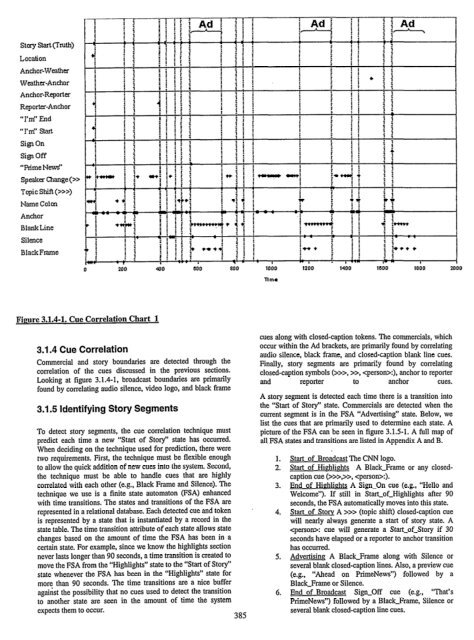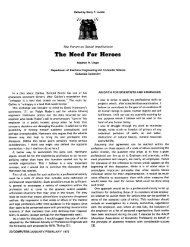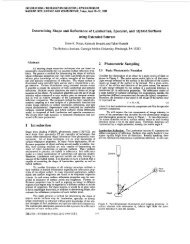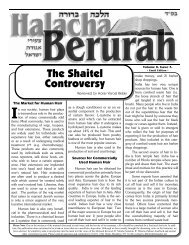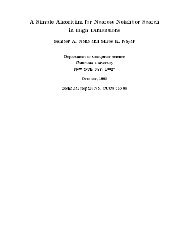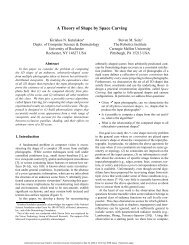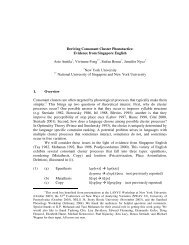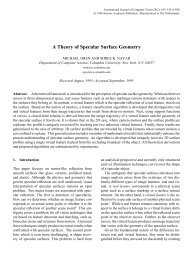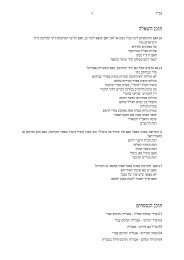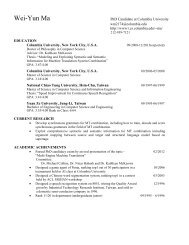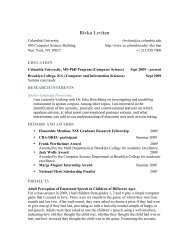Broadcast News Navigation using Story Segmentation
Broadcast News Navigation using Story Segmentation
Broadcast News Navigation using Story Segmentation
Create successful ePaper yourself
Turn your PDF publications into a flip-book with our unique Google optimized e-Paper software.
story staqrmth)<br />
Location<br />
Anchor-Weather<br />
Weather-Anchor<br />
Anchor-Reporter<br />
Reporter-Anchor<br />
“I’m” End<br />
“I’m” Staft<br />
Si@ On<br />
Sig Off<br />
“Prime NewS<br />
Speaker Change(>><br />
TopicSbift(>>2)<br />
Name Colon<br />
Anchor<br />
BlankLine<br />
Silence<br />
Black Frame<br />
Figure 3.1.4-1. Cue Correlation Chart 1<br />
3.1.4 Cue Correlation<br />
Commercial and story boundaries are detected through the<br />
correlation of the cues discussed in the previous sections.<br />
Looking at figure 3.1.4-1, broadcast boundaries are primarily<br />
found by correlating audio silence. video logo, and black frame<br />
3.1.5 Identifying <strong>Story</strong> Segments<br />
To detect story segments, the cue correlation technique must<br />
predict each time a new “Start of <strong>Story</strong>” state has occurred.<br />
When deciding on the technique used for prediction, there were<br />
two requirements. First, the technique must be flexible enough<br />
to allow the quick addition of new cues into the system. Second,<br />
the technique must be able to handle cues that are highly<br />
correlated with each other (e.g., Black Frame and Silence). The<br />
technique we use is a finite state automaton (FSA) enhanced<br />
with time transitions. The states and transitions of the FSA are<br />
represented in a relational database. Each detected cue and token<br />
is represented by a state that is instantiated by a record in the<br />
state table, The time transition attribute of each state allows state<br />
changes based on the amount of time the FSA has been in a<br />
certain state, For example, since we know the highlights section<br />
never lasts longer than 90 seconds, a time transition is created to<br />
move the FSA from the “Highlights” state to the “Start of <strong>Story</strong>”<br />
state whenever the FSA has been in the “Highlights” state for<br />
more than 90 seconds. The time transitions are a nice buffer<br />
against the possibility that no cues used to detect the transition<br />
to another state are seen in the amount of time the system<br />
expects them to occur.<br />
385<br />
SOD 800 1000 1200 1400 1800 1800 2000<br />
nme<br />
cues along with closed-caption tokens. The commercials, which<br />
occur within the Ad brackets, are primarily found by correlating<br />
audio silence, black frame, and closed-caption blank line cues.<br />
Finally, story segments are primarl!y found by correlating<br />
closed-caption symbols (>x+, >>, :), anchor to reporter<br />
and reporter to anchor cues.<br />
A story segment is detected each time there is a transition into<br />
the “Start of <strong>Story</strong>” state. Commercials are detected when the<br />
current segment is in the FSA “Advertising” state. Below, we<br />
list the cues that are primarily used to determine each state. A<br />
picture of the FSA can be seen in figure 3.151. A full map of<br />
all FSA states and transitions are listed in Appendix A and B.<br />
1.<br />
2.<br />
3.<br />
4.<br />
5.<br />
6.<br />
Start of <strong>Broadcast</strong> The CNN logo.<br />
Start of Highlights A Black-Frame or any closed-<br />
caption cue (>>>,>>, cpersoru:).<br />
End of Highlights A Sign-On cue (e.g., “Hello and<br />
Welcome”). If still in Star-of-Highlights after 90<br />
seconds, the FSA automatically moves into this state.<br />
Start of Storv A X+ (topic shift) closed-caption cue<br />
will nearly always generate a start of story state. A<br />
: cue will generate a Start-of-<strong>Story</strong> if 30<br />
seconds have elapsed or a reporter to anchor transition<br />
has occurred.<br />
Advertisinv A Black-Frame along with Silence or<br />
several blank closed-caption lines. Also, a preview cue<br />
(e.g., “Ahead on Prime<strong>News</strong>”) followed by a<br />
Black-Frame or Silence.<br />
End of <strong>Broadcast</strong> Sign-Off cue (e.g., “That’s<br />
Prime<strong>News</strong>”) followed by a Black-Frame, Silence or<br />
several blank closed-caption line cues.


